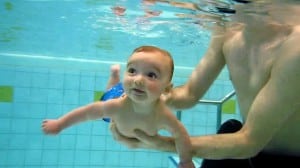This article will talk about the amniotic fluid that surrounds your baby in the amniotic sac, sometimes called the membranes. The first question is why does the baby swim in a pool in its mother’s uterus?
Imagine how your baby would develop if it weren’t surrounded by water. How could their limbs grow if they couldn’t move? Rather than a baby, it would be a lump of skin!
The membranes, commonly called the amniotic sac, play an essential role during pregnancy. This membrane originates at the edges of the placenta and will contain both the baby and fluids. The quantity of the amniotic fluid will vary from one woman to another, but it should increase as the pregnancy progresses. By term (around 37 weeks) it should read about 1 litre (1000 ml) of liquid. It will then gradually diminish to 700-800 ml until delivery.
The membrane will break either on its own or with assistance when you give birth to your baby. This liquid environment is your baby’s home for several months, and serves many purposes.
The roles of amniotic fluid
- It keeps the baby in an environment where the temperature is warm and stable
- Softens blows and generally protects the baby
- Hydrates the baby and collects its urine, maintaining a balance
- Allows the baby freedom of movement
- Protects the baby from potential outside infections
- Acts as a lubricant during the baby’s descent during birth
- Helps the development of the baby’s lungs and kidneys
Oligohydramnios, or Low Amniotic Fluid Volume
Oligohydramnios, or low amniotic fluid volume, is a pregnancy complication that usually occurs during the last trimester, and is a pregnancy anomaly that involves an insufficient quantity of amniotic fluid for the stage of pregnancy. Commonly, oligohydramnios is referred to when the volume of amniotic fluid is lower than 500 ml (usually 1000 ml), or 50% of the average amount based on pregnancy age.
According to the different sources I consulted, some state that from 0.4-4% of women will face this situation. Other sources state that it is up to 8% of pregnancies.
Why do some women have less amniotic fluid during their pregnancy? There are several possible causes of this issue:
Causes of lack of amniotic fluid during pregnancy
The potential causes are multiple and they can accumulate or be unique.
For the baby:
- Fetal malformation
- Defective fetal renal function (balance between urine and hydration)
- Growth delays
- A placenta that detaches or ages, which harms exchanges and balance
For the mother:
- A crack in the amniotic sac
- Taking certain medications
- Preeclampsia
- Gestational hypertension
- Diabetes
- Postmaturity (beyond 41-42 weeks)
- Identical twins with a single placenta
How is oligohydramnios diagnosed?
How is oligohydramnios diagnosed? The doctor (or health professional) that is monitoring your pregnancy checks the size of your stomach each appointment. The size should match the number of weeks in centimetres. For example, 28 centimetres at 28 weeks pregnant. The fundal height indicates the baby’s growth and the amount of amniotic fluid. If your fundal height is lower than the age of your pregnancy, an ultrasound might be necessary to check to see if the baby’s development and amniotic fluid are within norms.
If oligohydramnios is diagnosed, increased monitoring will take place to prevent complications associated with the issue. Your appointments will be closer together, increased ultrasounds, control monitoring of fetal activity, and you will have more blood tests.
Risks for the Baby
A lack of amniotic fluid can lead to the following situations:
- Malformations or defects
- Delayed growth
- Less absorption. The baby will move less, and the mother will feel more pain when they move
- It’s sometimes necessary to give birth prematurely
- A caesarean section may be required
- Possible fetal distress postnatal, often at the respiratory level
Solutions
There are no specific treatments for oligohydramnios. However, health professionals might try to deal with the potential causes to stabilise the situation and prevent the amniotic fluid from diminishing further.
Some medical procedures can add physiological liquid inside the amniotic sac, but it depends on each case.
Preterm childbirth may be necessary to prevent risks.
In conclusion, you have learned about low amniotic fluid volumes, but don’t be too worried about it. If your fundal height is right during your appointments, there are no issues. Additionally, if you are faced with the situation, the right people will be there to help you and answer your questions. You won’t face it alone!
Marie Fortier
The Baby Expert



